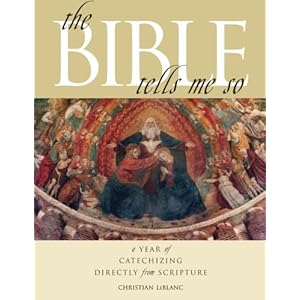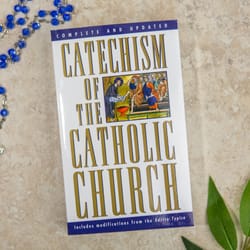Forming Intentional Disciples: The Path to Knowing and Following Disciples by Sherry A. Weddell – Our Sunday Visitor, 2012
There’s been a recurring conversation in my combox discussions over the past year, and I goes like this:
Jennifer: blah blah blah something about catechesis, evangelization, salvation of human souls, etc.
Smart Person: You need to read Forming Intentional Disciples.
So I stalked the review-book list at The Catholic Company, and quick pounced as soon as the title appeared. Grabbed it!
Part 1: The Church Has a Problem
It’s easy to shrug off the call for evangelization and discipleship by saying, “Oh, we already do that.” We have a men’s club. We have religious ed. Everybody’s happy, all are welcome, Jesus shows up for every Mass – but sure, I’ve heard other parishes are in trouble. Mine’s fine.
Maybe so. But Weddell opens the book with extensive and detailed evidence that no, things are not fine. She defines the scope of the problem both statistically – how many Catholics in the pews don’t even believe in a personal God? – and qualitatively. Here are the few of the seven “It is NORMAL” statements her parish’s Nameless Lay Group, a group of laymen gathered together to help each other grow in the faith, had to write out for themselves by way of reassurance:
. . .
#2. It is NORMAL for lay Catholics to be excited Christian activists.
#3. It is NORMAL for lay Catholics to be knowledgeable about their faith, the Scriptures, the doctrinal and moral teachings of the Church, and the history of the Church.
. . .
#6. It is NORMAL for lay Catholics to have the fellowship of other committed lay Catholics available to them, to encourage, nurture, and discern as they attempt to follow Jesus.
#7. It is NORMAL for the local parish to function consciously as a house of formation for lay Catholics, which enables and empowers lay Catholics to do #1-6 above.
[Emphasis in the original]
Is this true around your parish? It should be. Many Catholics don’t even believe in this as an ideal, and Weddell gives some poignant stories of how that pervasive mentality — of viewing holiness as a sort of sideline hobby for the ultra-pious — results in ridiculous contradictions.
She also works through all the objections to intentional discipleship, and demonstrates that yes, it is essential that we practice, at the parish level, the conscientious spiritual mentoring of all parishioners. This can’t be something we relegate to lay associations and solo study. This can’t be something we assume we don’t need to implement. We can’t tell ourselves that because no one has asked for this, all must be well.
Part 2: There Are Things You Can Do To Solve This Problem.
The second half of the book opens by explaining the five steps towards conversion — recognizing that no one can be a disciple of Jesus without first coming to faith in Him. The five steps Weddell outlines, and these should make sense to anyone who’s been involved in evangelization, are:
- Trust. You have to overcome your suspicions about the faith, and at have some kind of trustworthy connection with the Church. You won’t join what you can’t trust.
- Curiosity. This is a general interest in the faith — a willingness to learn something about it, the way one might casually go look up facts on Wikipedia about some random topic, without making a decision to do any more than go satisfy an intellectual whim.
- Openess. This is the transition from, “Oh I’m willing to learn a thing or two,” to, “It is possible that the Catholic faith is correct. I’m willing to accept this faith if it turns out to be true.”
- Seeking. The individual moves from an intellectual acceptance of the possibility, to an inner drive to know God personally. Seeking versus openness is the difference between, “Oh, sure, evolution might be true,” to “I must know whether it is true, and I will look into the matter until I come to a conclusion.”
- Conversion. This is when one becomes a disciple — the search is over, and now there’s a life of faith to be lived.
Weddell points out that seeking and conversion can be considered together as one continuous process. How do these stages fit into discipleship? In the detailed exploration of each of these stages, the book explores pitfalls and opportunities for the parish, and how these experiences can and should be lived out in the life of the Church.
In a final section, the book explores the “What next?” What do we do with new disciples? What structures does the parish need to have in place in order to disciple its members? A significant emphasis is placed on helping new believers — who may be longtime Catholics, or not — to discern their spiritual gifts, and then to find a place in the parish to use those gifts.
Here, as throughout the text, Weddell reminds us we aren’t dealing merely with good management practices or effective processes, but with the active participation of the Holy Spirit in the life of each person. It is easy to get distracted by methods, and forget that the supernatural — a personal God choosing to act in our lives — is at the heart of Christian discipleship.
Who should read the book?
Gosh, everyone, I guess. It’s written for parish leadership, and is suitable for anyone who wants to take an active part in Christian life. It would be foolish to think that somehow the nuts and bolts of evangelization and discipleship are only for church staff, or heads of ministries. Certainly I don’t think you can claim to have an adult faith if you neither know nor care about these matters — though if you doubt Catholics need concern themselves with this “evangelical” stuff, the book is particularly for you. For some few who’ve been raised to spiritual maturity in the right time and place, you may already have a mastery of the topic; but for most of us Catholics, we’re weak at this and can use all the help we can get.
The reading level is educated-adult — if you can read this blog, and make sense of the usual topics here, you’re good to go. The tone is conversational, and the writing is enjoyable and full of interesting anecdotes that impart useful information. If I have a single complaint, it’s that I wish the book were bigger and longer, and treated the how-to’s of discipleship with more exhaustive detail.
Summary: Excellent book, long-needed. I recommend it widely, but my copy is staying in my hands.
Disclosure boilerplate: This review was written as part of the Catholic book reviewer program from The Catholic Company. The Catholic Company is the best resource for gifts for every Sacrament celebration, such as First Communion gifts and Baptism gifts, as well as a great selection of limited-time Year of Faith gifts and resources. Not boilerplate: As everyone knows, my reviews are honest. And yes, I do make a point of picking good books for my review selections, because I have no patience for bad ones.














